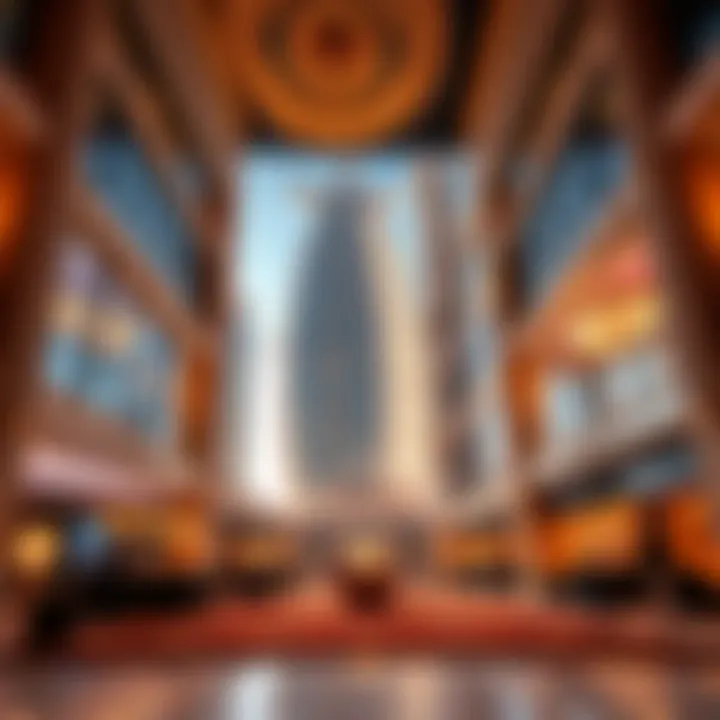Is Burj Al Arab Truly a Seven-Star Hotel?


Intro
The Burj Al Arab stands as an iconic structure on the horizon of Dubai's coastline, often boasting the distinction of being a 'seven-star hotel.' However, this label raises questions about its validity and implications within the hospitality industry. The narrative of a seven-star classification often hints at unparalleled luxury, but is there a concrete basis for this assertion? This article aims to dissect the layers behind the Burj Al Arab's reputation by exploring its features, industry standards, and what the term 'seven-star' really means in the context of luxury hospitality. For those contemplating investments or planning visits, understanding this nuance is essential to navigate the competitive Dubai market effectively.
Market Insights
Current Trends in Dubai Real Estate
The real estate market in Dubai is like a rollercoaster – ever-changing and full of surprises. As of 2023, trends indicate increased interest in luxury properties, especially those in the vicinity of landmarks like the Burj Al Arab. This has led to a surge in property values driven by tourists and investors eyeing the luxury market. Global economic conditions, shifting demographics, and evolving preferences have all played roles in shaping the current landscape.
- Luxury Appeal: The demand for luxury accommodations shows no signs of slowing down.
- Investment Opportunities: High-end developments attract affluent buyers and investors looking for lucrative returns.
- Sustainability: There’s a noticeable push towards eco-friendly properties, affecting new builds and renovations alike.
Economic Factors Impacting Property Values
Understanding the economic landscape is crucial for any investor looking to dip their toes in Dubai's high-stakes market. Several factors come into play:
- Tourism Growth: Dubai sees millions of visitors annually, many drawn by spectacular lodgings like the Burj Al Arab. This influx fuels real estate demand.
- Expat Communities: A diverse range of expatriates contributes to sustained interest in luxury real estate, emphasizing family amenities and location.
- Regulatory Environment: Favorable business conditions for international firms encourage investments in properties, further driving up prices.
"The combination of tourists seeking leisure and investors looking for prime opportunities has transformed Dubai’s real estate into a global hotspot."
Despite challenges such as fluctuating commodity prices and global economic shifts, the luxury segment continues to thrive, offering prospective investors a wealth of opportunities.
By grasping these market insights, one can better appreciate the standing of Burj Al Arab and its place in the larger tapestry of Dubai's hospitality and real estate sectors.
Understanding Hotel Star Ratings
Hotel star ratings play a crucial role in the hospitality industry, serving as a benchmark to assess the quality and level of service offered by establishments. For investors, agents, and travelers alike, these ratings provide a standardized method to gauge the experience expected when checking into a hotel. This article aims to dissect how these ratings are established, their historical journey, their criteria, and the variations seen across the globe—all of which are particularly relevant in the case of the Burj Al Arab, often dubbed a 'seven-star hotel.' By unpacking these dimensions, one can better appreciate the lofty aspirations behind such a label and its implications for luxury accommodation.
History of Hotel Rating Systems
Tracing the roots of hotel rating systems uncovers a tapestry interwoven with cultural norms and hospitality evolution. The modern star rating system is believed to have emerged in the early 20th century, with the Mobil Travel Guide, introduced in 1956, being a noteworthy player. It set the foundation for rating hotels based on various attributes. The concept grew, and by the 1960s, more organizations like Forbes had expanded this idea, establishing a more structured approach and utilizing inspections. Over the decades, additional guidelines and frameworks have appeared, reflecting technological advances and changing consumer expectations. This historical context serves as a backdrop against which the Burj Al Arab can be evaluated, considering its bold self-claimed status as a seven-star hotel.
Standard Criteria for Star Ratings
Star ratings typically consider several standard criteria that encapsulate the essence of customer experience. These criteria can vary significantly between rating organizations but commonly include:
- Location: Proximity to key landmarks and accessibility.
- Amenities: Facilities like pools, gyms, and spas that enhance guest comfort.
- Service Quality: Attentiveness and professionalism of staff, often evaluated through direct guest feedback.
- Cleanliness: Overall hygiene standards maintained in guest rooms and public areas.
- Dining Options: Range and quality of dining experiences available on-site.
While a five-star hotel would meet a definitive core set of these criteria, the distinguishing factor for establishments like the Burj Al Arab lies in its exceptional offerings that transcend the traditional boundaries set for five stars.
Variations Across Different Countries
The concept of star ratings is not universal; it adapts according to cultural perceptions and market demands. In many European countries, for instance, star ratings might favor architectural aesthetics and contextual historical significance, while in the United States, the focus largely remains on the service level and modern conveniences. Other regions may even adopt different methods, such as the Red Star rating in China, which emphasizes local luxury definitions.
Understanding these variations is essential for anyone analyzing the Burj Al Arab's status. The hotel's unique offering and its self-declared rating often cannot be simply aligned with any global standard; rather, it emerges from a complex interaction of local definitions of luxury and international expectations. This mosaic of influences sets the stage for the conversation around whether Burj Al Arab deserves its seven-star moniker.
Burj Al Arab: An Icon of Luxury
The Burj Al Arab stands tall as a symbol of opulence and an optical marvel in the heart of Dubai. Its unique sail-like silhouette cuts a striking image against the Arabian Gulf, attracting tourists and luxury seekers from around the globe. But beyond its aesthetic allure, Burj Al Arab offers a wealth of features that set it apart in the competitive hospitality landscape. This discussion shines a light on the various elements that contribute to its stature as a luxurious destination.


Architectural Significance
The design of Burj Al Arab is one of the first aspects that catch the eye. Created by renowned architect Tom Wright, its unique shape is not merely for show; it embodies innovation and advances in engineering. The building rises 321 meters above sea level, making it one of the tallest hotels worldwide. The exterior is clad in a dazzling white Teflon-coated fiberglass, ensuring it looks pristine against any weather conditions.
The engineering feats involved in the construction of such a masterpiece are remarkable, enabling it to withstand strong winds and seismic activity—characteristics vital in a region prone to both. The use of advanced materials and technologies amplified the modernist approach, setting a benchmark for future developments in hospitality architecture.
Unique Features and Amenities
Burj Al Arab boasts a plethora of unique amenities. From its lavish suites to its exclusive services, it offers an experience like no other. Each of the 202 duplex suites provides stunning views of the Gulf, with lavish decor and extraordinary attention to detail. Among the amenities, one might find the private beach, an infinity pool, and even a fleet of luxury cars at the guests' disposal, including Rolls-Royces and Bentleys.
Moreover, the hotel features a dedicated butler service for each suite, addressing guests' needs with exceptional care. This commitment to personalized service is a critical aspect of what distinguishes the Burj Al Arab from other luxury hotels. Whether it's arranging a shopping trip or securing reservations at one of the hotel's top restaurants, the staff goes above and beyond to ensure a memorable stay.
World-Class Dining Options
Dining at Burj Al Arab exemplifies a luxurious experience. With several world-class restaurants housed within the hotel, guests are treated to an array of culinary delights crafted by top chefs. Al Mahara, for example, offers a unique underwater dining experience with a captivating aquarium backdrop, immersing guests in an atmosphere that complements the fine seafood on offer.
Then there's the renowned restaurant, Al Muntaha, perched high up on the 27th floor, offering breathtaking panoramic views of the Dubai skyline and coastline. The menu is a fusion of international cuisines, making it a favorite for both locals and travelers.
In addition to these, the hotel also provides a range of casual dining spots and lounges, each with its identity and style. The overall approach to gastronomy at Burj Al Arab not only enhances guest satisfaction but also solidifies its reputation as a luxury destination that respects and celebrates culinary art.
"Luxury is not a necessity; it is an experience to savor."
Through its architectural magnificence, exceptional amenities, and outstanding dining options, Burj Al Arab truly embodies what it means to be an icon of luxury in the hospitality industry. Whether you’re a tourist seeking an unforgettable escape or an investor eyeing a prosperous venture, its allure cannot be ignored.
The Seven-Star Hotel Concept
When it comes to luxury accommodations, the notion of a seven-star hotel is quite a conversation starter. It raises eyebrows and conjures up images of opulence so high that they transcend the standard five-star system. But what really is the significance of labelling a hotel like Burj Al Arab as a seven-star establishment?
One key element of this concept is perception. The idea of a seven-star hotel implies exclusivity, luxury beyond common measures, and unparalleled service quality. While the official rating systems typically cap out at five stars, the term “seven-star” is often used more as a marketing strategy. It signals to potential guests that this hotel offers experiences that are intended to make them feel as if they are in a world apart.
Additionally, the seven-star label can be beneficial for brand positioning. For Burj Al Arab, such branding helps it carve out a niche in Dubai’s competitive hospitality landscape, setting it apart as an experience that is unmatched. In this day and age, where customers have extensive access to information and reviews, standing out can be the difference between booking and skipping out on a stay.
"A hotel is a place where people go to escape, but a seven-star hotel is where they go to experience the extraordinary."
It’s also worth noting the considerations that come with this label. Hotels aiming for such a high classification must genuinely strive to meet the expectations that come with it—think exceptional service, unmatched amenities, and overall guest satisfaction. That said, many critics argue that this label can mislead potential customers regarding what they should realistically expect. Essentially, the seven-star hotel concept serves as a double-edged sword; on one hand, it offers a thrilling draw for guests, while on the other, it risks setting unattainable expectations.
Ultimately, understanding the seven-star label and its implications sets the stage for a deeper investigation into whether Burj Al Arab can truly live up to this reputation or if it’s merely a fanciful title in the realm of luxury hospitality.
Origins of the Seven-Star Label
The origins of the seven-star label can be traced back to Jerry V. Lewis, a hotelier who was instrumental in launching this concept in the 1990s. According to reports, Lewis marked the Burj Al Arab as a seven-star hotel when it opened, believing that no existing rating system could encapsulate the sheer extravagance and unique offerings of the establishment. This self-assigned title was not bound by official criteria but rather filled a gap in the luxury market where hotels like the Burj Al Arab needed a designation that spoke to its grandeur.
Case Studies of Other 'Seven-Star' Hotels
While Burj Al Arab is frequently mentioned as a quintessential seven-star hotel, it isn’t alone in this exclusive club. Other establishments around the globe have sought to claim similar status. The Emirates Palace in Abu Dhabi is one notable example, boasting features that align closely with those of Burj Al Arab. The staggering architecture, gold-plated interiors, and remarkable customer service signal its allegiance to the same elite branding that a seven-star designation offers.
Furthermore, the Seven Stars Galleria in Milan serves as a prime example beyond the Middle East, combining the aspects of luxury retail and hospitality under one roof. This multi-faceted approach has heightened the guest experience, further solidifying its place in the conversation about seven-star accommodations.
Public Perceptions and Misconceptions


Public perception of seven-star hotels, including Burj Al Arab, can be a minefield of assumptions and misconceptions. On one hand, many view such labels as a representation of an unparalleled experience. However, others regard them skeptically, arguing that the absence of official endorsement renders the label moot. Critics suggest that it perpetuates an overinflated sense of what luxury should entail.
Moreover, potential guests might mistakenly think that a seven-star designation guarantees absolute perfection. While Burj Al Arab is indeed exceptional in various aspects, no establishment is immune to occasional service lapses or guest dissatisfaction. It’s crucial for travelers to approach such claims with a discerning eye, recognizing that while the experience promises to be extraordinary, real-life experiences can differ from marketing promises.
Comparing Burj Al Arab to Global Standards
When it comes to assessing a hotel like the Burj Al Arab, comparisons with global standards are crucial. This process allows potential guests and investors to decipher whether the claims made about the hotel’s luxury status hold water. The Burj Al Arab stands as a distinct beacon of opulence in Dubai, yet it also holds the bar up against other luxurious establishments worldwide. Evaluating it by established standards sheds light on what sets it apart or aligns with its contemporaries.
Understanding how Burj Al Arab fits within these classifications enables a deeper appreciation of its offerings. Rather than merely a place to stay, it aims to deliver an experience wrapped in sophistication and exclusivity. This is not just about sumptuous suites and breathtaking views; it also involves ancillary aspects—like guest services, architectural finesse, and fine dining—that culminate into what one can expect from a top-tier hotel.
Evaluation Against Five-Star Classifications
In the hospitality industry, five-star classifications are often viewed as the gold standard. Factors assessed usually include location, facilities, and service levels. The Burj Al Arab channels these elements in a way that raises the bar. Not only does it offer a lavish room adorned with gold leaf and Italian marble, but it also boasts a unique shape, becoming a symbol of modern architecture itself.
- Service Quality
- Facilities Offered
- Dining Experiences
- Staff-to-guest ratio is exceedingly favorable. This not only ensures personal attention but also expedites service delivery.
- Attentiveness and professionalism of the staff are often recognized by guests and reviewers alike.
- Not just a pool, but an infinity pool that overlooks the Arabian Gulf gives guests an unparalleled view.
- Spa and wellness options that can rival standalone spas are available, reinforcing that wellness isn’t an afterthought but a priority here.
- Signature restaurants that have earned accolades establish a culinary journey rather than just a meal.
Despite garnishing praise, one cannot overlook the critiques. Some guests point out high prices attached to the exclusivity. Others argue that not every experience lives up to the elevated expectations set by the hotel's luxurious reputation. Still, the Burj Al Arab succeeds in maintaining its prestigious rating through consistent service and remarkable promise.
Guest Experiences and Reviews
When it comes to customer reviews, the narrative surrounding the Burj Al Arab is varied. While many rave about the luxurious aspects, others note areas where expectations have perhaps been too high. Guest reviews often serve as a litmus test for potential visitors looking into the hotel experience.
- Positive Takeaways
- Critiques and Suggestions
- Guests frequently laud the thoughtful nuances in service, from personalized greetings to special arrangements on significant occasions.
- First-time visitors often describe the immediate wow factor upon entering the grand lobby; it sets a precedent for everything that follows.
- Some reviews mention the sheer scale of opulence can lead to feeling overwhelmed or even indifferent to the luxury.
- Additionally, guests suggest that certain rooms may not justify the high rates when compared to competitors in the same tier.
Ultimately, the experiences are subjective and speak volumes about individual preferences. Travellers aiming for extravagance might find the attention to detail and architectural splendor gratifying. In contrast, those seeking a more grounded experience might feel it’s all a bit over the top. Overall, the Burj Al Arab consistently ranks highly on review platforms and can stand toe-to-toe with reputed hotel chains across the world.
"A hotel isn’t just about luxurious accommodation; it’s about how a stay leaves you feeling once you’ve returned home."
Assessments against global standards, paired with guest reviews, reveal much about Burj Al Arab’s overall worth. They highlight it as a memorable destination for some, while others may find it’s not their cup of tea. Understanding both sides can offer valuable foresight for anyone considering a visit, and also adjust expectations based on specific desires.
Economic Impact and Investment Potential
Understanding the economic impact of the Burj Al Arab is critical not just for the hotel itself, but also for the broader hospitality sector in Dubai and beyond. As one of the most recognizable symbols of luxury in the world, its influence stretches far into tourism, real estate, and even local culture. For investors looking to capitalize on this lucrative sector, knowing the nuances of its success offers substantial benefits and considerations.
Tourism Trends in Dubai
Dubai has become a beacon of luxury tourism, attracting millions of visitors annually. In the last decade, the city has experienced a tourism boom, largely driven by its innovative developments, extravagant lifestyle, and robust infrastructure. The Burj Al Arab, standing majestically against the backdrop of the Arabian Gulf, contributes significantly to these trends.
- High-Profile Events: Dubai hosts numerous events, from global conferences to high-stakes sporting competitions. The hotel often serves as both a venue and a high-end accommodation option.
- Luxury Tourism Growth: There is a continuous increase in affluent travelers seeking unique experiences. The Burj Al Arab caters to this demographic, often seen as a preferred stay for celebrities and dignitaries.
- Diverse Attractions: Beyond shopping and fine dining, Dubai increasingly positions itself as a cultural hub. The Burj Al Arab sometimes collaborates with local art galleries and exhibitions, enhancing its international appeal.


With such dynamics at play, it's clear that the Burj Al Arab isn't just a luxury hotel; it's a major player in shaping tourism trends in Dubai, impacting local businesses and communities.
Role of Burj Al Arab in Dubai’s Luxury Market
When assessing the luxury market in Dubai, the Burj Al Arab acts as a benchmark. It sets standards for service quality, amenities, and overall guest experience. By analyzing its role, several key points emerge:
- Price Positioning: Room rates at the Burj Al Arab reflect its exclusive offerings. This creates a tiered market where luxury hotels must compete not just on price but on unparalleled service and unique experiences.
- Investment Attraction: The Burj Al Arab serves as a model for other luxury developments in the region. Its success attracts investors looking to emulate that prestige, pushing others to elevate their offerings.
- Cultural Impact: The hotel influences local perceptions of luxury. As such, it helps define what tourists expect when they visit Dubai, inspiring other hotels to reach for that same level of excellence.
"The Burj Al Arab doesn't only symbolize luxury; it shapes the landscape of Dubai's hotel industry, influencing expectations and investment strategies across the board."
Burj Al Arab: A Benchmark for Future Developments
The Burj Al Arab stands not just as a pillar of luxury in Dubai but also as a trailblazer for future developments in the hospitality sector. Its unique architecture and unparalleled service set a high bar, encouraging new luxury hotels to rethink their offers. As the industry evolves, this establishment's influence is vast, prompting various stakeholders to adapt and innovate.
Lessons for New Luxury Hotels
New luxury hotels can glean several lessons from the Burj Al Arab's success. Firstly, distinctive architecture is paramount. The iconic sail-shaped silhouette isn't merely for show; it's a symbol that draws attention and becomes part of the city’s identity. A hotel’s physical presence can make all the difference in attracting guests.
Secondly, tailored guest experiences are critical. The Burj offers personalized services that cater to its guests’ every whim. Hotels lacking customization are likely to fall short in today’s competitive arena. Potential guests should feel unique from the moment they arrive.
Moreover, leveraging strategic partnerships can elevate luxury offerings. The Burj collaborates with top-tier brands for experiences—from gourmet dining to exclusive spa services—both enhancing guest satisfaction and generating buzz.
- Focus on architectural uniqueness to create an identity.
- Invest in personalized experiences that make each guest feel special.
- Forge strategic partnerships to boost offerings and broaden appeal.
"The Burj Al Arab is more than a hotel; it's an experience, a lifestyle, and a destination in itself."
Future of Luxury Hospitality in Dubai
Looking forward, the future of luxury hospitality in Dubai appears promising. With a thriving tourist economy, the demand for unique experiences continues to grow. Future establishments must not only replicate the high standards set by the Burj Al Arab but also innovate continuously to maintain guest interest and relevance.
Emphasis on sustainability is becoming critical. As more travelers prioritize eco-friendly practices, hotels will need to think creatively about how to integrate sustainability into luxury. This could include reducing waste, utilizing renewable energy, or offering organic dining options.
Furthermore, digital transformation plays an integral role. Implementing technologies such as AI for personalized service, smart-room features, and seamless booking processes can significantly enhance the guest experience.
Finally, fostering a rich cultural experience is essential. Dubai, being a melting pot of cultures, provides a unique backdrop for luxury hotels to offer immersive cultural experiences, from art exhibitions to culinary classes highlighting regional cuisine.
End: The Essence of Luxury
By now, it’s evident that the conversation surrounding the Burj Al Arab and its claim to be a seven-star hotel is layered with intricacies. The essence of luxury as embodied in this iconic structure goes beyond mere star ratings; it reflects a commitment to unparalleled experiences, excellence in service, and architectural brilliance. With every detail meticulously curated, the Burj Al Arab acts not just as a hotel but as a symbol of the heights to which hospitality can aspire.
Summation of Insights
The exploration of Burj Al Arab’s true standing unveils several key insights:
- Unique Offerings: From its distinctive silhouette to its opulent interiors, the Burj Al Arab provides an experience unmatched in the world of luxury hotels.
- Service Excellence: Guests are not merely treated well; they are lavished with perks and personalized attention that solidify their perception of staying in a truly elite venue.
- Cultural Significance: This hotel encapsulates the spirit of Dubai, where modernity meets tradition, showcasing the city’s rapid growth and ambition.
Furthermore, the discussions around star classifications shed light on how these ratings often fail to capture the nuances of luxury. While traditional measures focus on tangible elements, the intangible qualities—like ambiance and emotional impact—also play a pivotal role in defining a hotel’s stature. According to sources such as Britannica and Wikipedia, definitions of luxury are subjective, often influenced by cultural perceptions.
Final Thoughts on the Seven-Star Debate
The term "seven-star hotel" may be more of a marketing tool than an industry standard, yet it sparks considerable interest and debate. The Burj Al Arab’s alignment with this label invites both admiration and skepticism.
Ultimately, the essence of luxury cannot be distilled into a simple rating. Instead, it embodies a multitude of factors:
- Client Relationship: The hotel nurtures devoted clientele who see it as a second home.
- Investment Attraction: For investors and developers, recognizing what defines luxury can lead to lucrative opportunities within the hospitality sector.
- Benchmarking Future Developments: As competition grows, the Burj Al Arab sets a high bar for emerging luxury hotels, demanding innovation and exceptional standards.
In closing, as one reflects on the unique blend of opulence, innovation, and service that Burj Al Arab offers, it becomes clear that luxury is more than just stars—it’s a living experience that continually redefines itself. The conversation about whether it deserves the seven-star title is less important than the broader implications of what luxury hospitality means in the modern world.







